Is the image above something you could see on a Magic card? What if I told you this wasn’t created by an artist, but rather the artificial intelligence generator Midjourney, using a prompt: /imagine Overgrown Farmland, Fantasy, Gothic Horror, Plains, Forest, Magic: The Gathering. This was the first in a series of tests with the program to see if I could create Magic: The Gathering illustrations using this brand new technology.
If this artwork appeared at card size, many folks would likely not notice anything out of the ordinary. It looks at home in a world that is familiar to players, has a reasonable amount of detail, and appears, on the surface, to show farmland that is being overgrown with something otherworldly. But is it of the same kind and quality of those works created by artist’s working for the game, imbued with the same storytelling and soul we see on a regular basis? That answer is no.
Regardless, the advent of AI artwork looks to incite change within the industry, and today we’ll take a closer look at exactly what it is and what it could mean for the world of Magic and other art-intensive properties. I had a lot of questions when I began: Can AI generate artwork for the game, even though it lacks artistic intent? Is it a tool for artists in creating concepts that will work for their assignments, as we’ve seen artists begin to do? Will this technology cause problems in the world of copyright, plagiarism, and forgery? Will there be people that try to pass AI artworks as their own? We’ll touch on all of these as I tested a series of examples, but first let’s define exactly what we’re talking about.
What is AI artwork, and How Does It Work?
This is a very heavy subject, and what follows is my attempt to distill it down into something that makes sense for the purpose of this article.
Artwork created by artificial intelligence is not new, and dates back to the 1960s, when Harold Cohen developed a system called AARON. You can explore some of his creations here. As technology and programming language has advanced, AI used generative adversarial networks, or GANs, where two artificial neural networks are trained to compete with each other in a zero-sum game to discriminate between true and false images. But last year’s release of CLIP (Contrastive Language–Image Pre-training) from Open AI seemed to change the game and build on GANs, and as reported by The Register earlier this month, led to the current generative models that allow text descriptions to inform image choices.
To see exactly how these generative systems work, I turned to a close friend with his doctorate in the field who is intimately familiar with these processes. He was able to find a very useful article to use as a baseline if folks were especially curious, and paraphrase it for better understanding:
“The goal of GANs is to generate new images which could have plausibly come from the original dataset. Two models are trained to ‘compete,’ in that one model is trying to generate new images and the other is trying to classify them. This process repeats in that the generator and discriminator keep going back and forth until the generator generates images that fool the discriminator ~50% of the time. In other words, when it gets to this 50%, that means that the generator is generating images that can be recognized as coming from the original source, but are also different enough to where they actually look new, which is the goal of the task.”
The AI generator we’ll be using for this article, Midjourney, uses the improved-GANs, CLIP-guided diffusion model according to founder David Holz in this interview with The Register. Midjourney has yet to reveal its tech stack, only saying that they’re using green energy to generate the millions upon millions of images it creates per day.
What is Midjourney?
Midjourney, in their own words, is “an independent research lab exploring new mediums of thought and expanding the imaginative powers of the human species.” They are a team of only 11 people, led by David Holz and a group of seasoned advisors from the tech space, and have just recently launched in Open Beta their AI Art Generator of the same name. The program uses Discord as its front-end service, and while the initial server quickly reached its cap, they have been recently expanding access across other Discord servers.
The first 25 queries for new users are free, and publicly visible for all Midjourney users to see and use. Paid, Private, and Corporate plans are available once the initial trials have been expended.
An easy to understand User Guide walks “newbies” through exactly how to create their first image. Using the /imagine command in Discord, users can add whatever it is they’d like to see, and the Midjourney Bot will create four images based on the text input.
From here, users can either Upscale or create Variations. Upscaling renders one of the images to 1024×1024 pixels and adds more detail, while Variations creates four new images based on the previous image. Once an image has been Upscaled, users can Upscale to Max at 1664 x 1664 pixels, create Variations of the Upscaled image, or Light Upscale Redo, which will re-Upscale the previous image and remove some of the detail. Each one of these functions uses a “job.”
Images can be saved or shared, or sent via Discord Direct Message for use later. Paid subscribers can create images using the same process above, but within the semi-privacy of the Discord Direct Message feature as opposed to an open channel. All images, regardless of where they are generated, must abide by the Code of Conduct and Full Content Guidelines.
Midjourney & Magic: The Gathering
That was a lot of background to get to the meat and potatoes of this AI expedition, and we’ve come to the point of departure to explore the application of this artificial intelligence within the constraints of generating artwork for Magic: The Gathering. The results are nothing short of curious, cutting-edge, and maybe just a touch concerning. I used a variety of different prompts, stated in different ways and drawn from different sources, and as such got an array of artwork of all kinds and quality. What follows is not in the order in which they were queried, but rather re-arranged for maximum understanding. Let’s start easiest and most general.
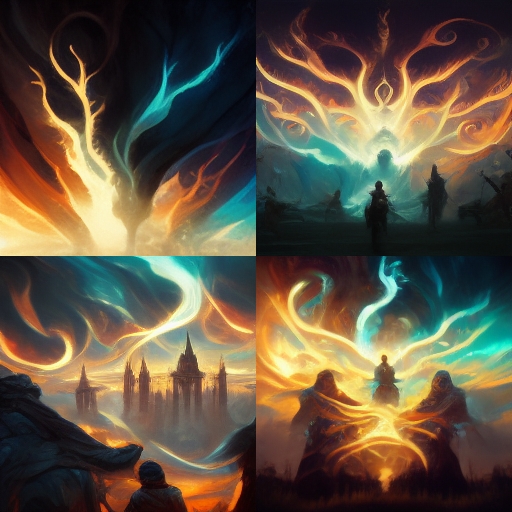
/imagine Magic: The Gathering
A very literal take on the entry, but also one that could very much exist on a card called Gathering Magic. Stylistically it’s very similar to the images that follow using “fantasy, Magic: The Gathering,” which leads me to believe the system does know what it is and has seen at least some artwork during its training. Going one step further, this is what arrives for a Basic Land, a Mountain.
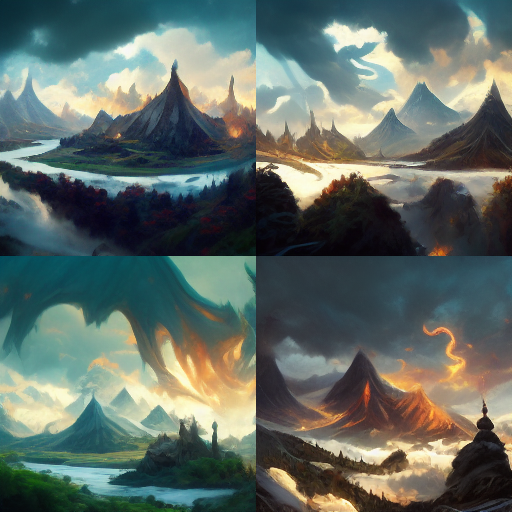
/imagine Mountain, fantasy, dragons live there, Magic: The Gathering
This looks fairly reasonable from a compositional standpoint, and could very much be the building block of a full-fledged illustration. I didn’t say land or basic land in the prompt and yet it did return a landscape. The “dragons live there” seems to be missing, though the wisps and structure in the sky that’s reminiscent of a dragon’s wing in the third image is a nice touch; it’s also very possible this is unintentional, or an accident, or I’m infusing my own storytelling into the image.
It would make sense that landscapes would be more straightforward, but what about creatures and figures? What happens if I add specific, plane-based language in? Will it know? Does it change things?
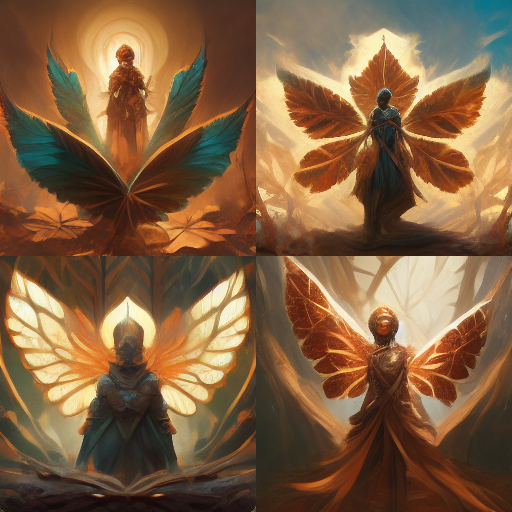
/imagine copper-leaf angel, fantasy, Dominaria, Magic: The Gathering
This was only my second Midjourney attempt, so imagine my surprise right on the heels of the Overgrown Farmland we saw at the beginning. The AI generated four angel-like figures with interesting compositions and unique elements, and once again I chose one to upscale.
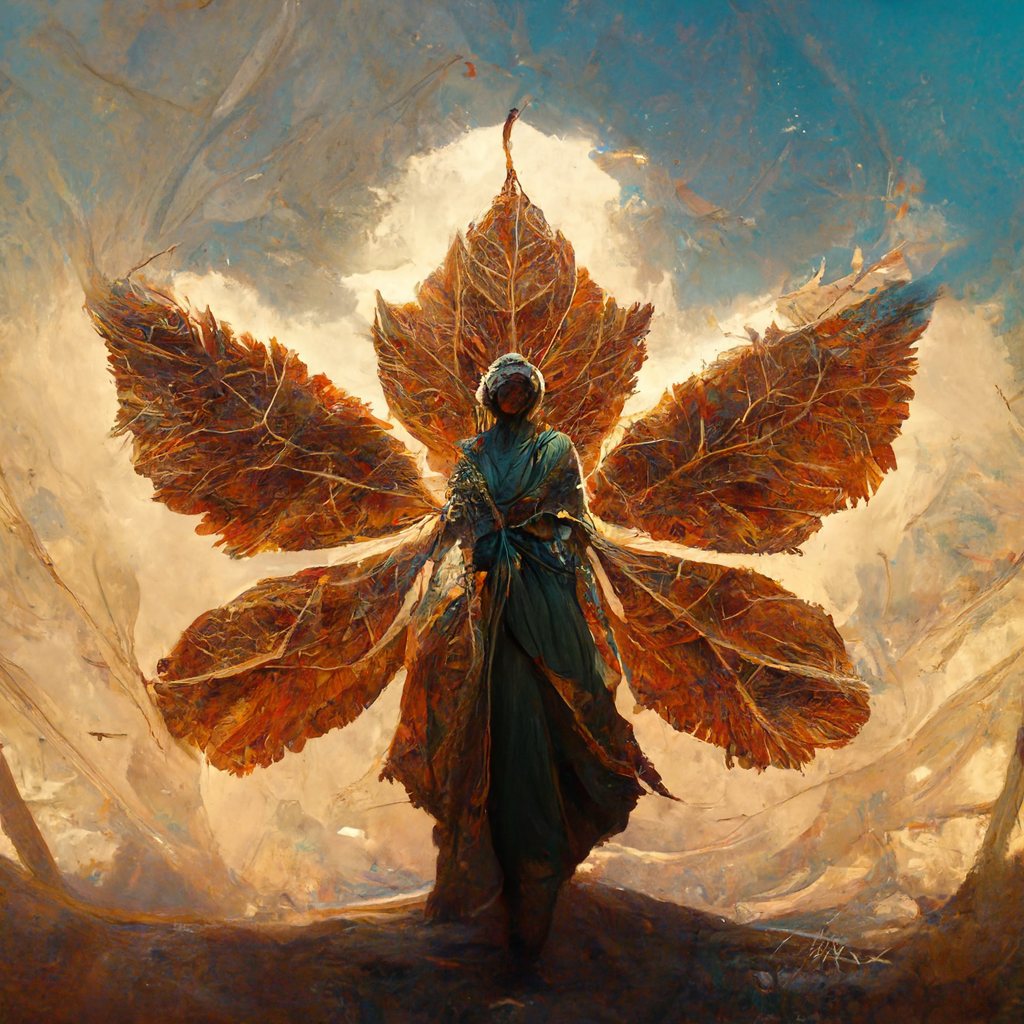
It’s an interesting take on the idea of a copper-leaf angel, and very usable compositional concepts that could be built upon. And at small sizes, they do look very compelling. But a word of caution: just because something looks good and can act the part does not mean it is great art. AI artwork’s biggest weakness is a lack of intent, and that lack of storytelling and emotion is something we’ll see continue throughout these examples.
Staying on this plane, I wanted to try and create a legendary figure. Scryfall’s Random Generator game Jolrael, Mwonvuli Recluse first, and I went from there:
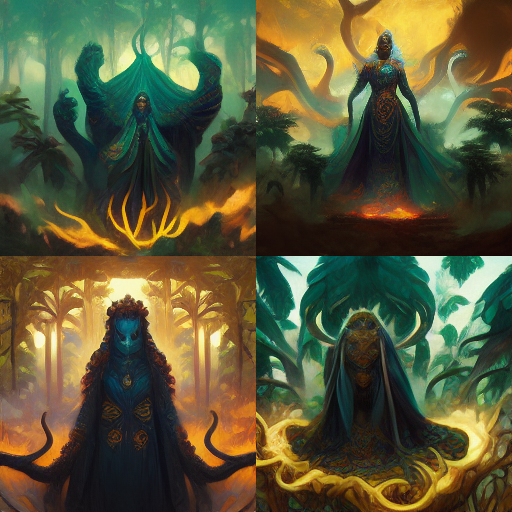
/imagine Jolrael Mwonvuli Recluse, Jolrael Empress of Beasts, Zhalfirin Mage, Legend, Legendary Creature, Jamuraa, Jamuraan Forest, Dominaria, Fantasy, Magic: The Gathering
That’s a whole lot of words, but we see again some interesting concepts surrounding a central figure within a forest. I went one step further and upscaled the second image to here:
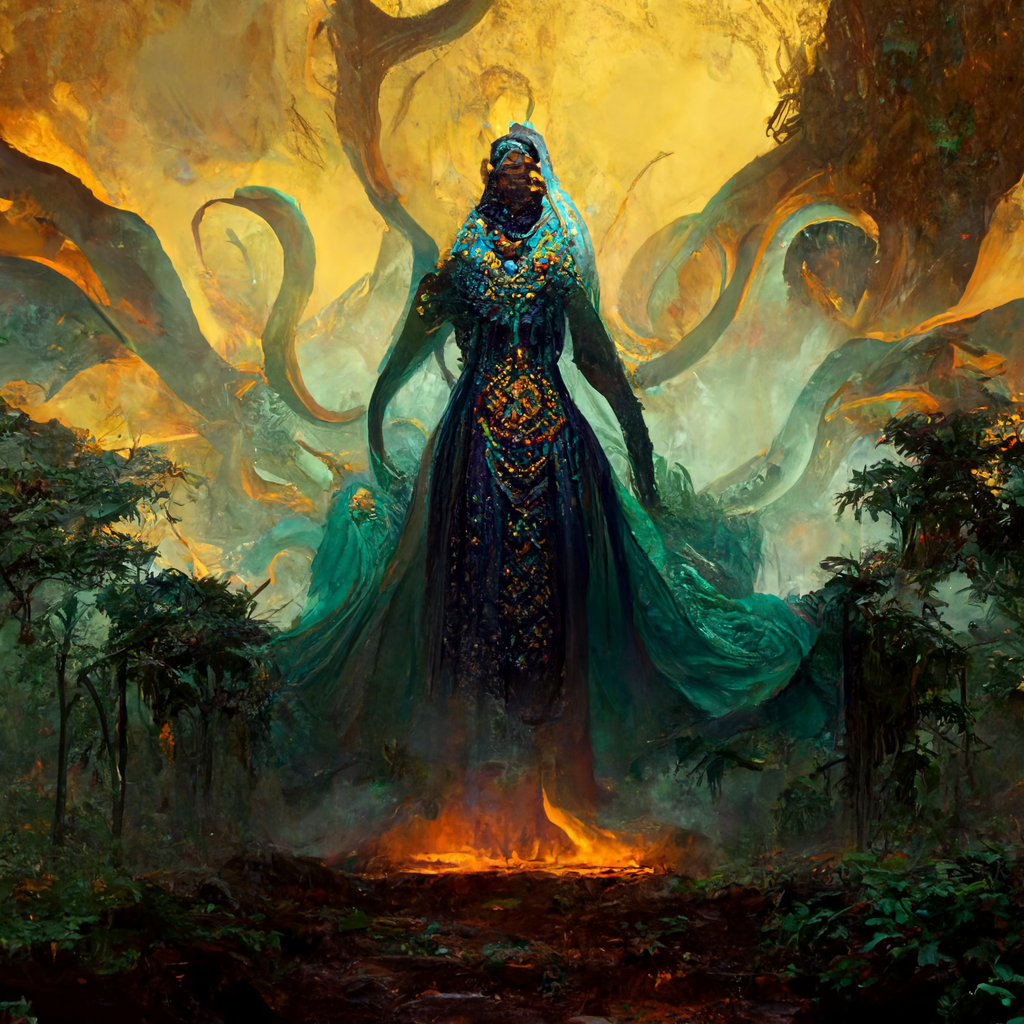
On its own it’s incomplete. But this would make a very cool composition for a legend of the forest that needed to be depicted larger than life or upon the precipice of an important event. Imagine a fully rendered Jolrael emerging from Jamuraa, with her forest beats lashing against the sky. Pretty cool right? Again, the concept is here, but we also see again some shortfalls, chief among them that the AI does not render faces unless specifically asked? Or does it?
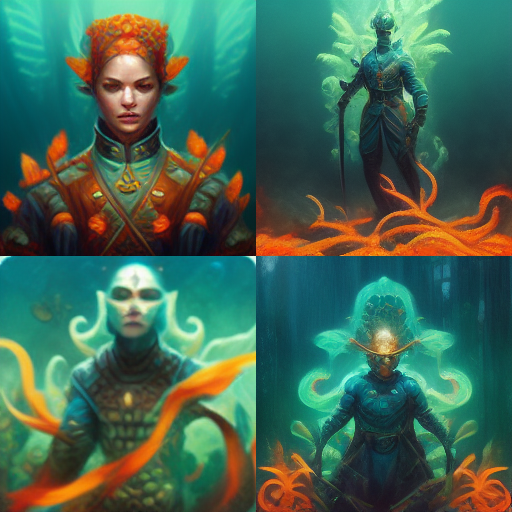
/imagine Coralhelm Commander, Merfolk, Soldier, Zendikar, Magic: The Gathering
This was the only test that resulted in a fully rendered human-like face, and appeared in only one of four variations. To dig deeper, I both upscaled this image:

And then created variations of this artwork, to see exactly what the AI would do.
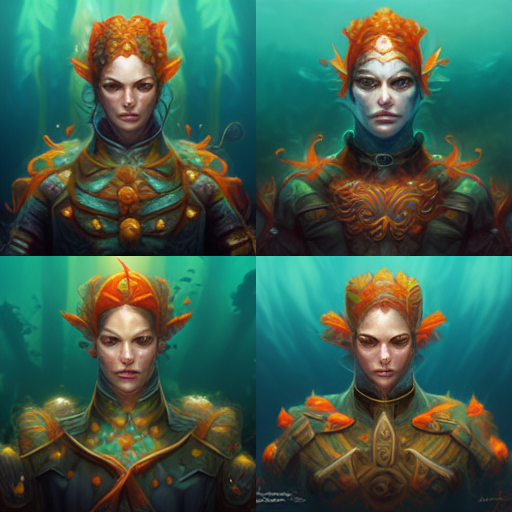
The results provide a lot of diversity within that fairly narrow merfolk-but-also-a-soldier vein, and gives a fair amount of variety in color and costume to boot. My favorite of the four was actually the fourth due to its centralized composition and addition of the throne (likely derived from “commander”), which I also upscaled.
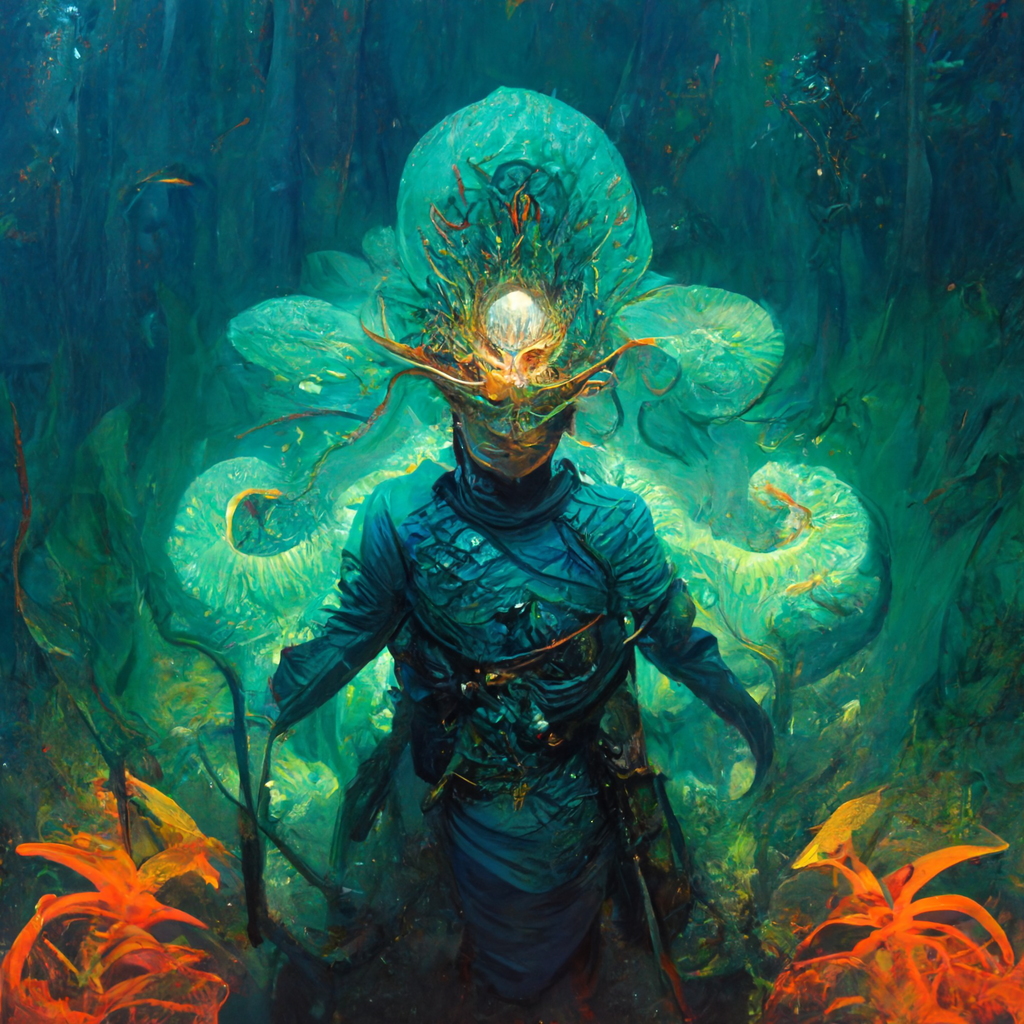
The result is undeniably pretty cool, but these examples still just reinforce the AI’s place as a concept art generator that lays out the building blocks, but not quite creating fully immersive illustrations to tell stories on cards. It’s also the first instance of an underlying homogeneity in composition, placing strong figures central with details based on other keywords around them. It’s dynamic, and it works, but it begins to get repetitive.
I’ve got a few more examples, and we’ll go fast. Of the ten prompts, only one was a pretty firm miss.
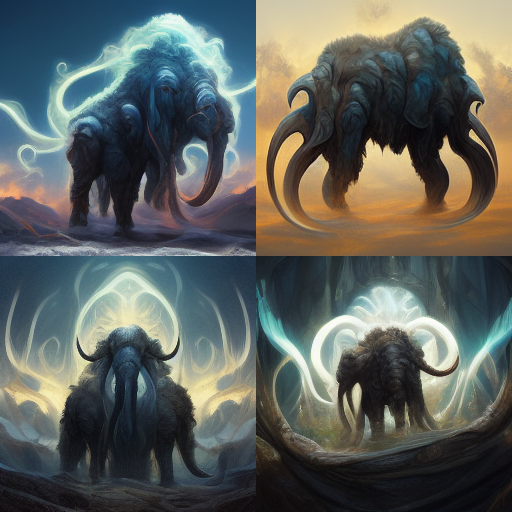
/imagine Mammoth Umbra, Fantasy, Spectral, Wooly Mammoth, Armor, Magic: The Gathering
This is certainly not an easy one and the most obscure of the bunch, and we even see some of the same compositional techniques repeated, just with a different subject, perhaps as a crutch as the system struggled with understanding what I meant. There is real potential with the first result, and perhaps that would be the jumping off point for a future illustration. Next, I wanted to make sure I tried an artifact, and went with the all-star of my latest Commander deck, Thrumming Stone. Remember, to thrum is to make a continuous humming sound.
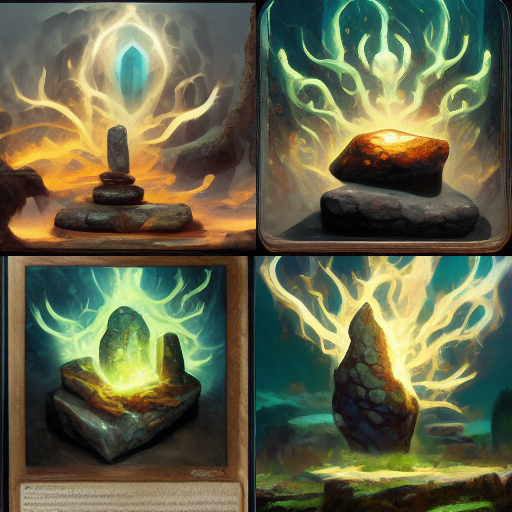
/imagine Thrumming Stone, Fantasy, Artifact, powerful, Magic: The Gathering
This is, interestingly enough, the only result that accounted for the frame of the card as one of the options. These are also reasonably homogenous, both between the four and compositionally compared to the other pieces we’ve seen. But they do look like the roughs for a Magic card illustration, and do capture the idea behind a powerful stone emanating a powerful sound.
The final test was to take actual Magic: The Gathering illustration prompts and feed them to the AI, to see if a dearth of detail made any difference. I turned to the Ultimate Masters Art Description page and picked two cards. First up, Bitterblossom:
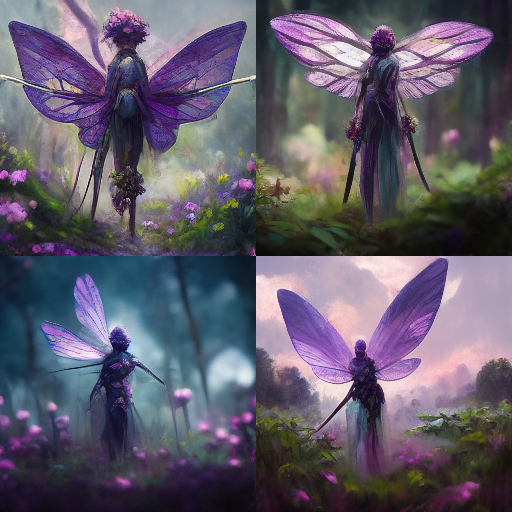
/imagine Purple Faerie with Dragonfly wings and barbed spear in the foreground, Background is a Magical Glen where Faeries emerge from hiding places among the flowers, wild purple flowers, magenta flowers, blue flowers, Lorwyn, Black Spell, Fantasy, Magic: The Gathering
Admittedly I forgot to include the card name as I’ve done before, and made no mention of the faeries in the background. I also left out any style descriptors (as I did with all of these). But even despite these oversights, the AI created some fantastical faeries that very much have the look and feel of what Bitterblossom could be. It still needs the human touch, but the foundation is there.
The last work for today is Life from the Loam, created with the following distilled from the original art description:
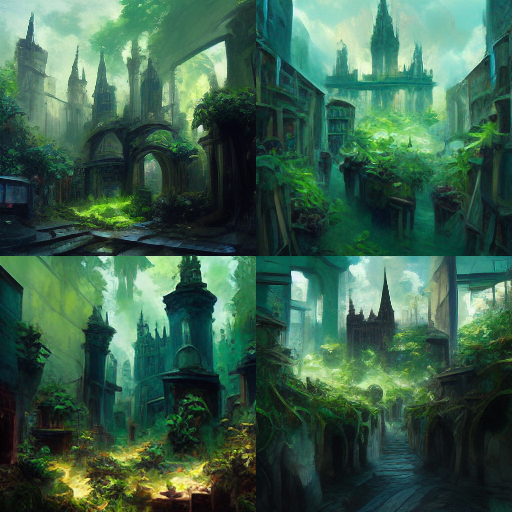
/imagine A dead, forgotten place has transformed into a new living realm, nature reclaiming the undercity of an urban area, Life from the Loam, Fantasy, Ravnica, Green Spell, Magic: The Gathering
This was perhaps the closest result to artwork we’d expect to see on a Magic card, it is quite close in subject and style to the card artwork by Sung Choi. As such, I took each of these one step further via Upscale, and here were the results:
These are pretty impressive, and as we saw with some of the others, a majority of folks would probably play right along if they opened this artwork in a booster pack during Friday Night Magic. The pitfalls we’ve seen earlier, of homogeneity, missing intent, and incomplete storytelling are still present. But in this example, “pretty good” could very well be “good enough” in some applications, and that’s maybe the most concerning part of this whole experiment.
There were a hundred more things I could have entered, changed, or added, but for now, let’s summarize some take-aways from what we’ve seen above.
Wrapping Up
My takeaways from this exercise are as follows.
AI will not replace artists. It is shaping up to be an incredible artistic tool for idea generation, concept art, thumbnailing, and artistic exploration, but it itself still craves the finishing touch of a creative human mind. And perhaps most importantly, there are a lot of questions that still need answering because it’s so new in this form, from copyright to royalties to artist and style blocklists, none of which I’ve had the resources to cover (but all of which you can dig into a bit deeper within a recent Twitter thread from Karla Ortiz). Ortiz asked Midjourney a lot of these difficult questions and has only gotten a bare minimum of answers, so it remains to be seen if these answers exist, are still being formulated, or the answers simply won’t be one’s the artistic community wants to hear.
There is another AI called Dall-E-2 from Open AI that seems to be the other current elephant in the room. I am on the waiting list for their Beta, and once granted access will run a similar experiment (with many of the same prompts) in an effort to better understand its capabilities. Be on the lookout for that likely early next year.
The TL;DR for Midjourney MTG is not to panic. Artists aren’t going anywhere, and they’ve got a pretty cool new tool in their toolbox, if they should decide to use it. That said, the art community as a whole should be vigilant in watching this technology, where and how it develops, and what might come next. I’ll be doing my best to stay up on this emerging technology; it’s moving very, very fast, and something we all must pay attention to. Stay tuned.
Donny Caltrider has been playing Magic since 2002 and collecting original Magic art since 2017. He has an M.A. in Museum Studies from Johns Hopkins University and enjoys telling stories about art, objects, and the intersection of fantasy with real-life. You can find him on Twitter talking about #mtgart, museums, and other #vorthos related goodness. Follow along and continue the conversation!

